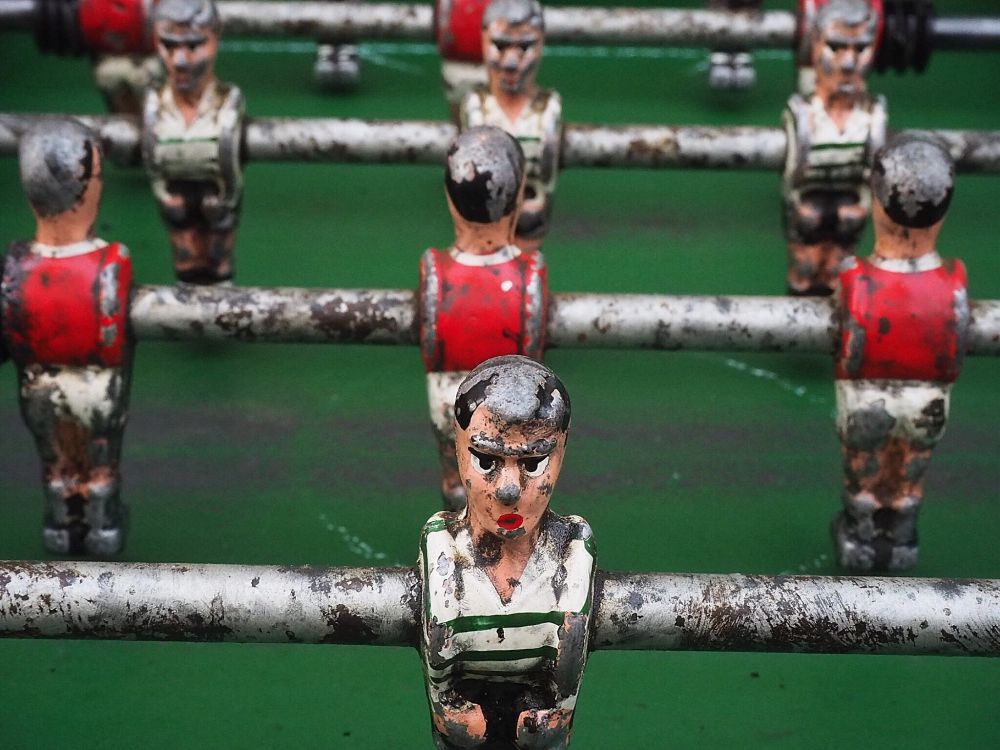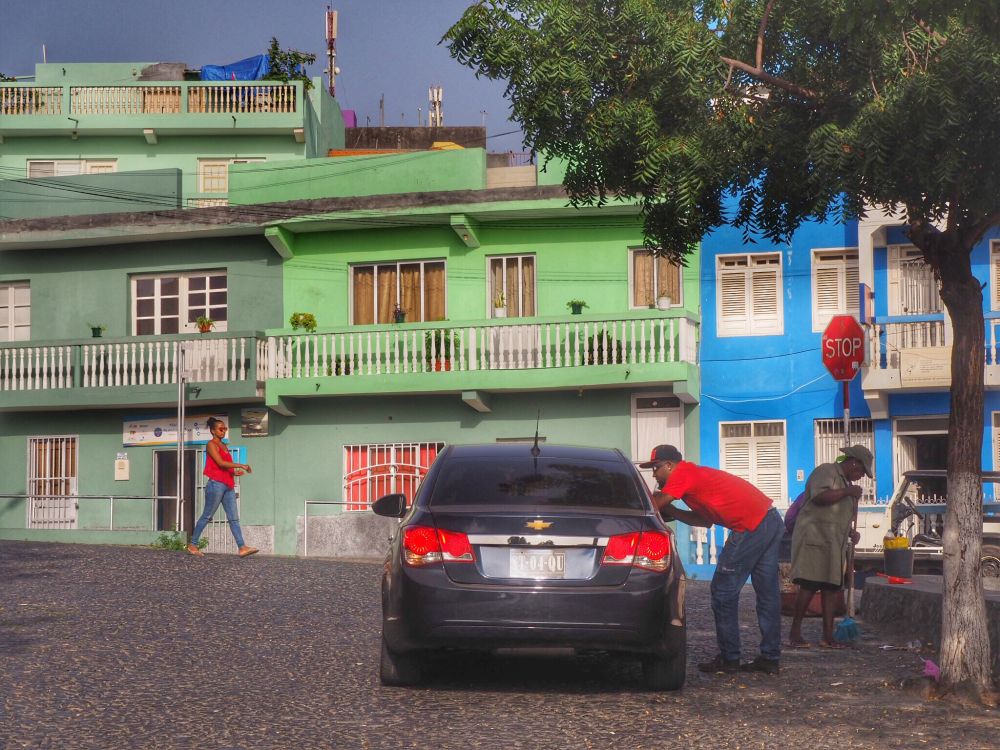’It’s constantly windy and there is nothing there.’ Some friends tried to dissuade me when we talked about Cape Verde. Luckily I didn’t listen to them because I was sure there had to be SOMETHING worth seeing. I was ready for my very own Cape Verde experience!
Why Cape Verde?
As winter was coming I longed to be in a warmer place to recharge my batteries with sunshine. Although the Canary Islands are good for that purpose too, if we spent two more hours in the air, we end up not only in late spring weather but in guaranteed summer climate. By African standards, it’s a safe country and there is no need for vaccination. And to top it all, the time difference is not significant, just two hours, so jetlag doesn’t trouble you either.
Best time to visit Cape Verde
The climate is similar all year long, only the amount of precipitation varies. It’s best to avoid the period from August to October as that is the wettest.
Where is Cape Verde?
Cape Verde is in the Atlantic Ocean, approximately 570 kilometres (350 miles) off the western coast of the African continent. Cape Verde consists of 10 larger (out of which 9 are inhabited) and 5 smaller islands.
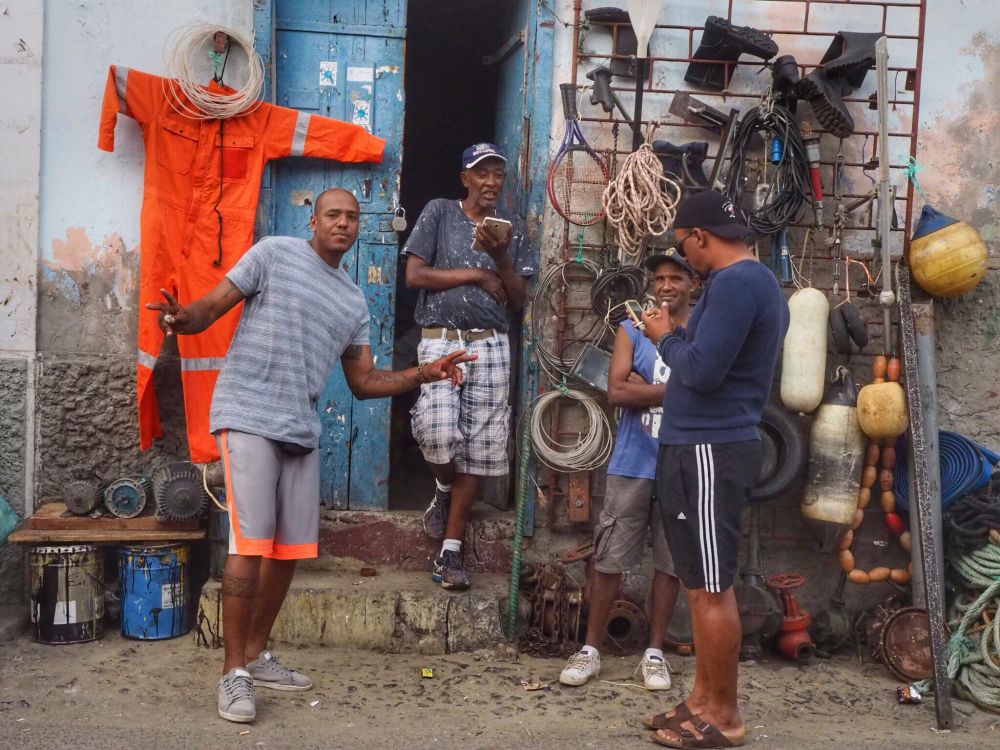
Travel to Cape Verde
We can reach Cape Verde with TAP Airlines, with a stopover in Lisbon. It’s advantageous that TAP flies to more than one of the islands. For example, I arrived in Santiago and left from Sal, checking out two islands in one trip; halfway through the journey I witnessed quite a sunset.
Cape Verde entry requirements
Your passport has to be valid for 6 more months after entering Cape Verde. Many nationals may pick up their visa at the international airport upon arrival for 25 Euros.
Planning a Cape Verde experience
Most tourists arrive in the island of Sal, where the beaches are the nicest, where the all-inclusive resorts are and where most international flights arrive. I myself flew home from here, but decided to see a few other islands beforehand because guidebooks say they have different characteristics. The lucky winners were the islands of Santiago (located here is the only World Heritage site), Santo Antao (the most beautiful hiking trails) and Sal (it’s best to hit the beaches on this one).
Transportation between the islands
You can shuttle between the islands using airplanes, except the Sao Vicente–Santo Antao route, which can be done by ferry. For me the 4 inter-island plane tickets (Santiago to Fogo and back, then Santiago to Sao Vicente and on to Sal) cost 500 USD all together, all bought at the Binternanarias regional airline.
Transportation on the island
You can travel in three ways on the islands. There’s the local public transport, which consists of minibuses (alugueres) travelling on pre-defined routes. They have no fixed timetables, they leave when they are full. Being „full” does not mean the same thing here, that a passanger sits on each seat, but rather that the bus is 150% full. It was here that I realized that space can expand: a passenger with a 90-cm hip can fit in the 20-cm space between two rows if a plank of wood is placed between the seats. You just end up a bit closer to your fellow passengers. 🙂
There are no fixed bus stops, you have to wave to them or call out to the driver if you wish to get off. If there is more than one driver inviting you to get in their bus, you should get in the one with the most passengers, as that is the most likely to hit the road first. There was a time we actually spent 40 minutes looking around for passengers until at last we started out.
It’s quite an experience to travel in these alugueres. Not your conventional great experince. It’s very hot, my sweaty arm pressing close to that of my neighbors, riding on the road full of potholes, looking out for donkeys and cows. Traverses taken with full speed, music blasting from the speakers so loud I thought it would be impossible to hear each other over it, but my fellow passengers proved me wrong. The driver talked on his cellphone all the way – by now I would be scared only if he put it down, he’s so used to driving like this. All together it was a real nightmare and still I felt peace and happiness. Then I wondered why I was grinning, and I realized that the passengers of the bus were in such high spirits, they could hardly contain themselves. Whenever we stopped to pick up somebody new, no one grumbled, complained, threatened or got mad as it would’ve been „normal” for me (as I grew up in an environment like that). They simply rearranged themselves every time to make space for the newcomer – even if they had to get out and back in for a new formation. And they laughed a lot. I gladly recharged from their good spirits.
Most tourists rent a taxi, though it’s much more expensive – I don’t know how much, as I didn’t rent one. Then there is the option of the classic rent-a-car, which is quite expensive here due to the limited car pool, 50-70 euros a day, so I skipped that too.
As there are no „must see” sights on the islands, I decided I spent quite enough money on the inter-island tickets, so I’ll be on a tighter budget and go where I can with the minibuses. I made only one exception to get to the vulcano Fogo (more on that later), but I got lucky with a tourist friendly price.
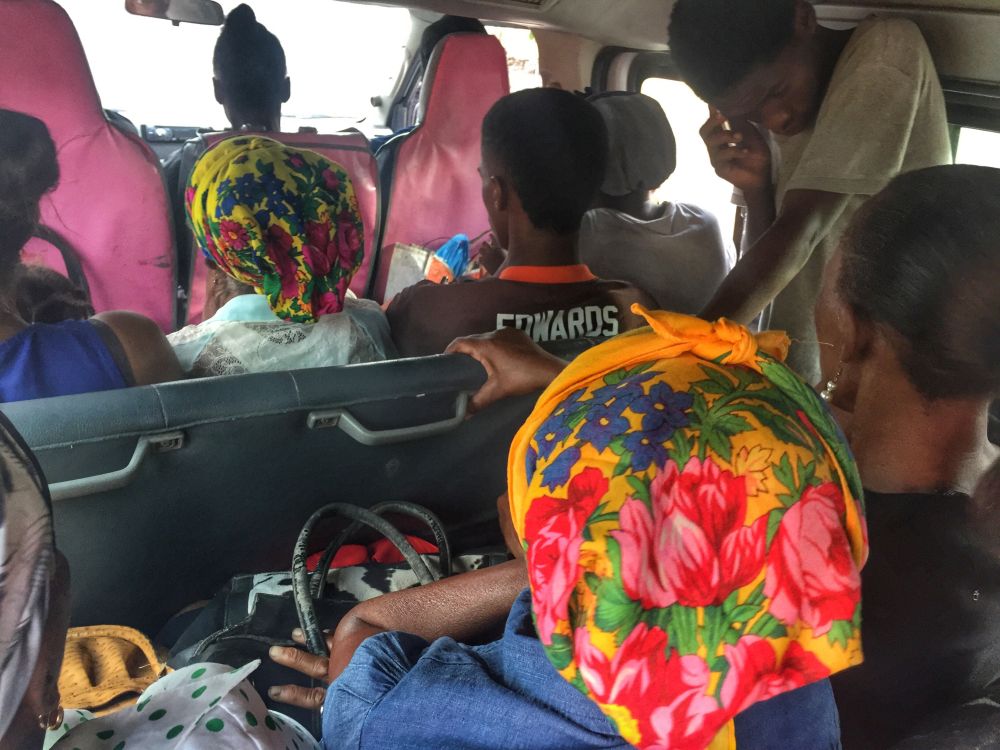
1. SANTIAGO
Praia
About half of the population of Cape Verde (270.000) lives on the island of Santiago, and of this about 140.000 in Praia, meaning this is the metropolis of the region. That said, it doesn’t have many exciting sights but its center – the Plateua – is worth a walk. As in other places of the third world, locals would never admit to not knowing something. When you ask for orientation they rather point in random directions than not say anything. It’s better to download maps.me to have its offline maps and make your way using that.
The best thing in the capital is most probably the market, colorful and loud as always.
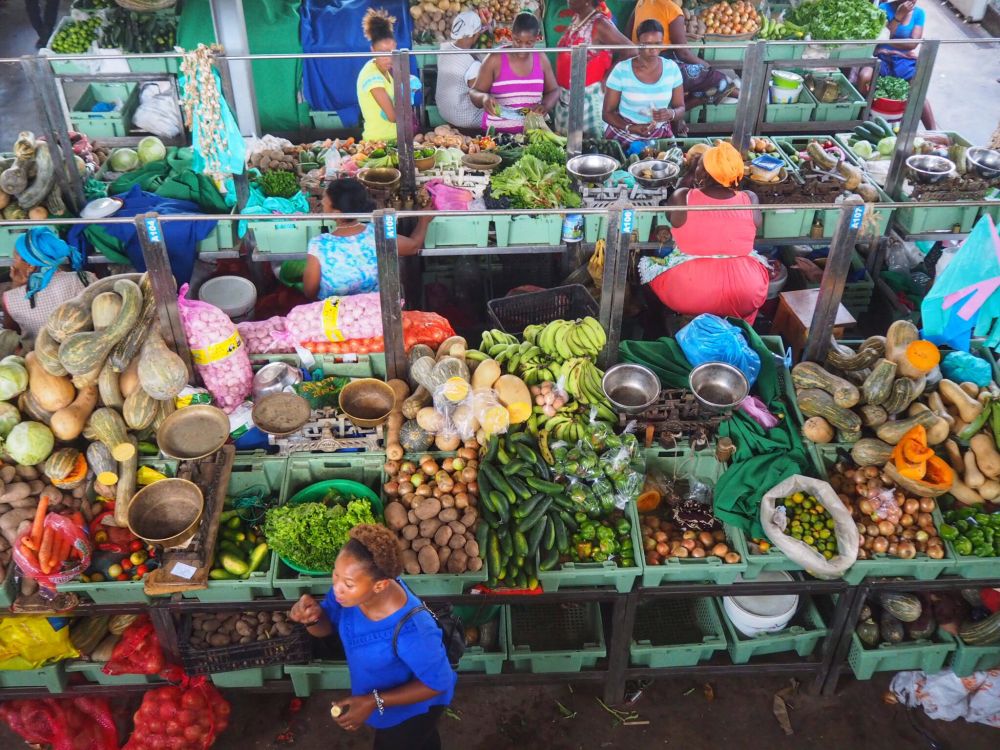
Cidade Velha
The only World Heritage of the islands is the old capital, Cidade Velha. The town is 500 years old, and it was the first European city in the tropics, south of the Sahara. Proving its magnitude, it was admitted to the World Heritage list in 2009. When in 1462 the Portuguese discovered the then uninhabited island, a few settlers founded the first city. They gave it the name Ribeira Grande (great river) – and so the sad history of the islands started. Until it reaching its independence in 1975 everything was just squeezed out from it – from slaves to sugar cane to coal mines.
Going downhill you get a great view of the city.
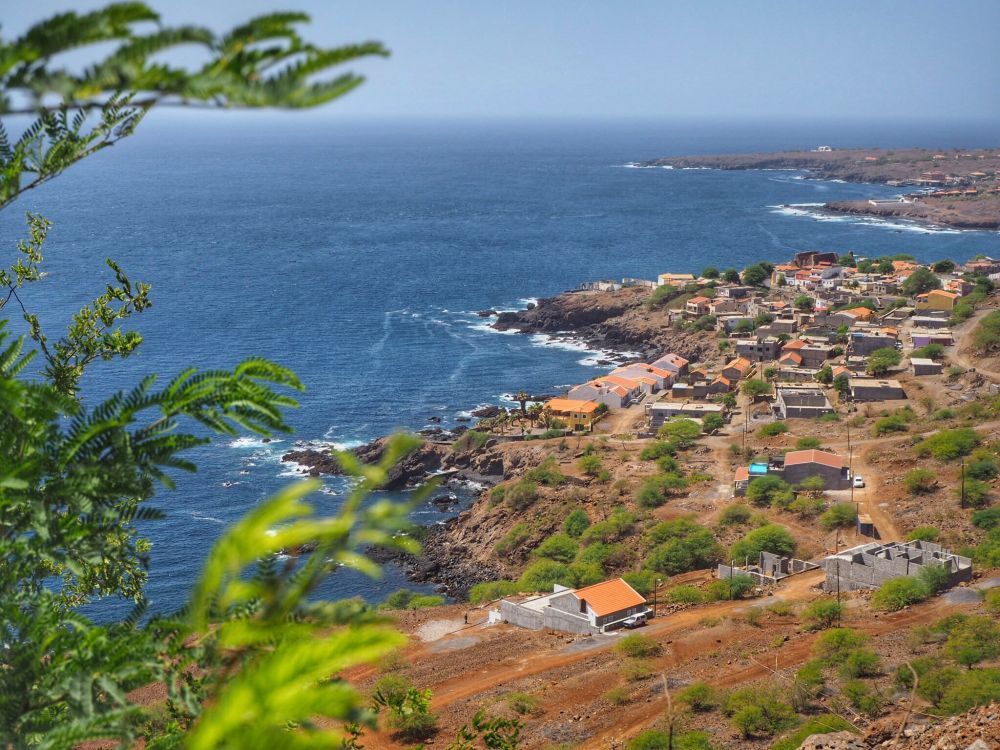
The oldest colonial church of the tropics and an imposing cathedral ruin can be found here. This latter was built in 1693 but lasted a short time, in 1712 it was reduced to ruins by French pirates. The cathedral is in the center of town, but you can find more churches along the dried up river bed. It’s worth climbing up here also because of getting a better view on locals’ lives.
You can find a small market in the main square among the adorable colorful houses. On the black sand beach perfect for a short swim, there are a few fish serving restaurants too.
With the minibus you can reach Cidade Velha from the capital in about 30 minutes, and it will cost you 100 CVs (one euro).
Tarrafal
The beaches of Santiago cannot compete with those of Sal, but there are a few ones good enough for a swim. Of these, the most popular is Tarrafal. The minibus from the capital is 500 CVs (5 euros) and about 2 hours. Looking at the map it was obvious that there are two roads leading to Tarrafal from the capital, which is in the other corner of the island. One road leads through the middle of the island winding between mountains and hills, the other along the beach. I was lucky to experience both, as I had no idea which we will take when getting in the minibus.
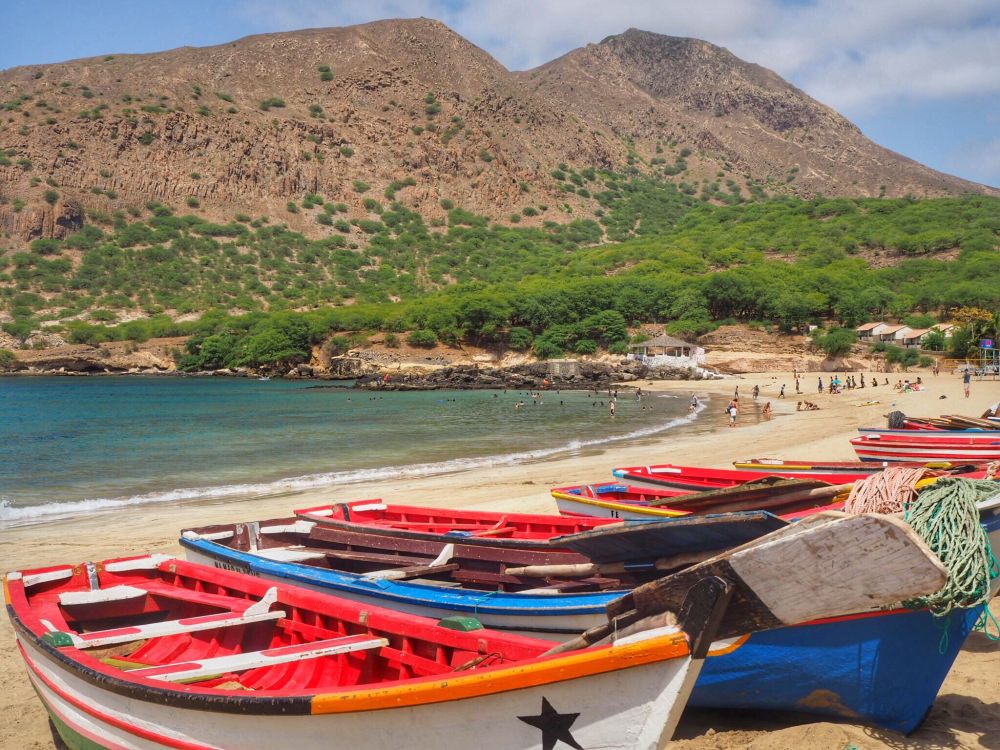
The town’s center has adorably colorful houses here as well.
I found a great restaurant in one of the off the beaten track streets. As none of the touristy restaurants on the beach were sympathetic enough to me I was lucky to find Buzio where I heard the music of Cesaria Evora. Though no one there spoke English (the translation of the menu was: fish, fish, fish, fish, fish, fish, fish, fish, no fish, no fish, no fish, no fish), the tuna I ordered tasted wonderful.
Bus stop
The originally 12-person minibuses flash around the main roads of the island all day. In Praia you can hop on one of them on the Sucupira market. The market itself is a huge experience, apart from the usual clothes, shoes and gift products you can also find car washes and pedicurists.
Accomodation
I slept in two places in Praia (one before the trip to Fogo, the other after that). The first place was a simple inn, the Hotel Cesaria. Here a one bed room cost 4.000, the two bed room cost 6.000 CVs (40 and 60 euros respectively). Clean, friendly, nice breakfast on the roof terrace, close to the market from where the minibuses leave. The only drawback was that though I booked a one bed room, they put me in a two bed room and in the end wanted me to pay the latter’s price. I told them that if they put me there without my consenting to the higher price, they cannot charge me with that price. They backed down immediately and I paid the original price.
My second lodging was a bouitque hotel, more elegant than the previous one, and obviously more expensive too. The Boutique Hotel Pescador is closer to the beach – about 2-3 minute walk. This was clean, nice and it too had a roof terrace where they served breakfast.
Here you can find further lodgings in Praia on Booking.com.
2. FOGO
Originally I went to Fogo because of its natural beauty, if you can call the black volcanic land beautiful, but its inhabitants were the ones to give me a lasting experience.
Fogo, the neighboring island can be reached by a short half an hour flight from Santiago, but it’s a totally different world one enters. The largest town is Sao Filipe, it’s from here that you can take trips and hikes throughout the island – first and foremost to the top of its volcano. There is a small airport outside the town from where the minibus takes you to downtown for 300 CVs.
The volcano on Fogo is still active today, erupting last in 2014 and annihilating two villages. The reason this event did not reach us is probably that miraculously no one was hurt, everyone managed to get to safety. To locals this eruption was nothing new, as the volcano erupted back in 2005 as well. It seems here they treat it as an everday unpleasantness and don’t bother with it – the lava barely cooled off, they were already building a new village. Not even the fact that the road was wiped out by the lava flow could stop them. They started off into the still warm lava-field carrying their stuff on their heads.
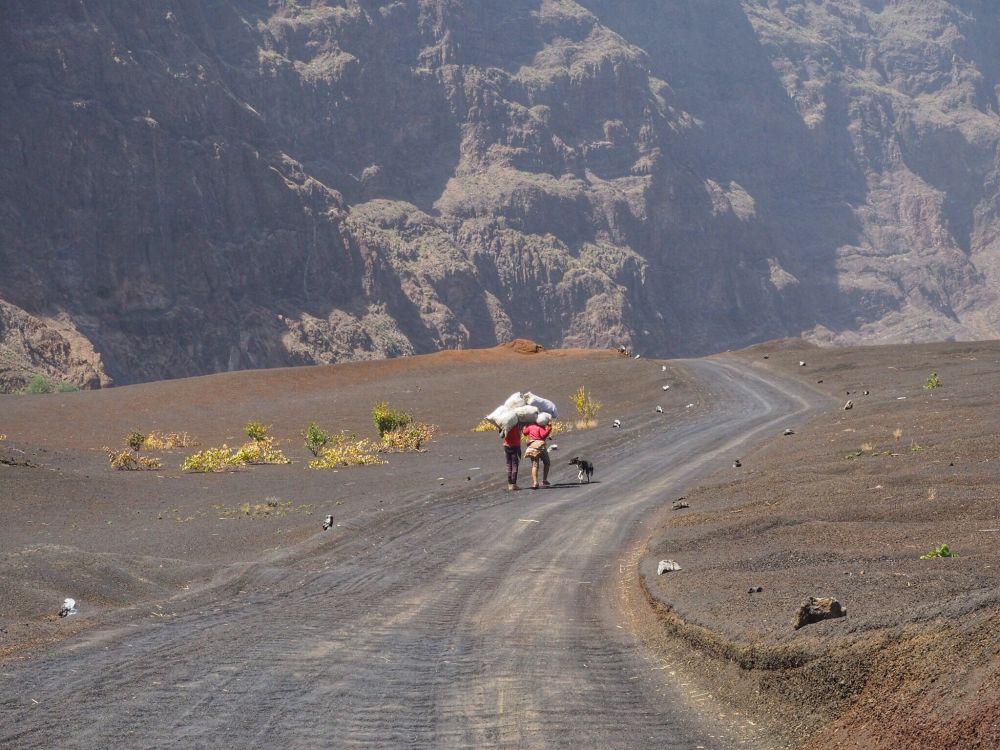
Traditional houses blend into their surroundings, built from the rocks lying around. There is no electricity or water nearby – the latter they try to collect from rainwater. Locals living here in these harsh circumstances grow grapes on the volcanic ground.
It’s a surreal feeling to be walking on the volcanic field among the annihilated villages. There are houses that are completely covered by lava, but looking at other, taller buildings, it simply flowed into them.
A whole village lies beneath the lava-field. The largest immersed building was a winery. This is the second that was ruined, the first was in 2005, by the other eruption. People aren’t giving up easily, the third winery is already built.
After the eruption of 2014, the locals started rebuilding almost immediately, ignoring the government’s remonstrance. They not only built simple houses, but also a hotel with a restaurant especially for tourists wanting to visit and climb the volcano – this is Casa Marisa (but there are other B+B’s as well).
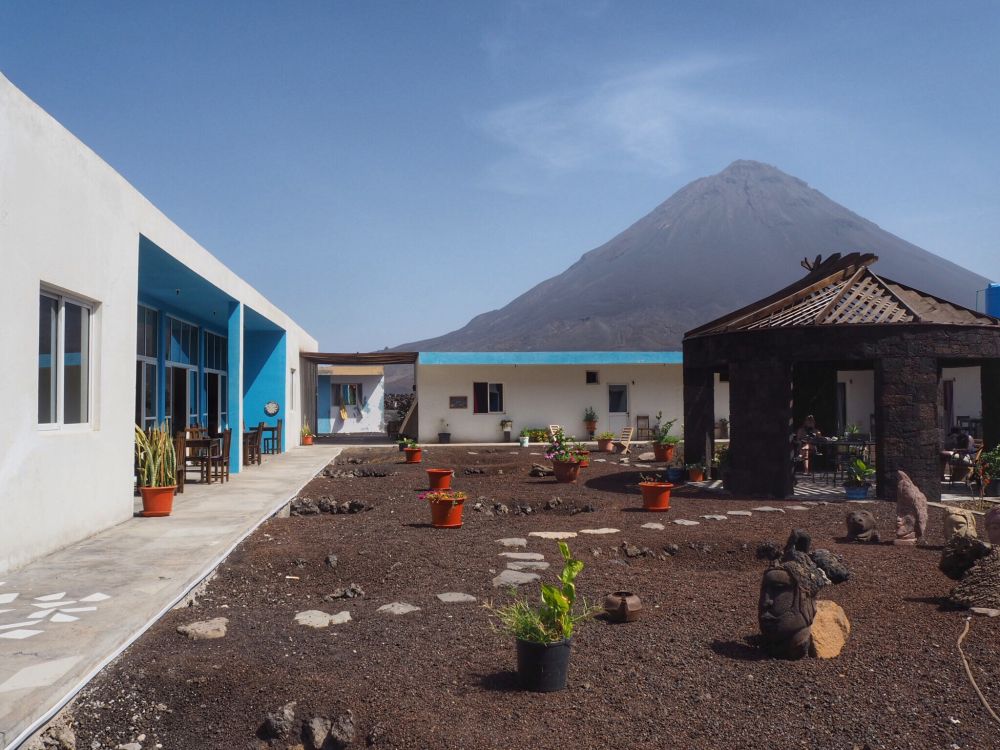
Apart from the usual hotel rooms, you can also rent a few local stone houses. One of the favorite dishes of the restaurant is cacupha, which is a local one-course dish. There are a million versions of it throughout the islands as its essense is to put anything you have at home in the dish. The main ingredients are beans and some kind of meat, complemented with vegetables, fish, eggs. Two types of wine are made from the grapes: a dry one and a sweet one; it is not overcomplicated as the labels aren’t either.
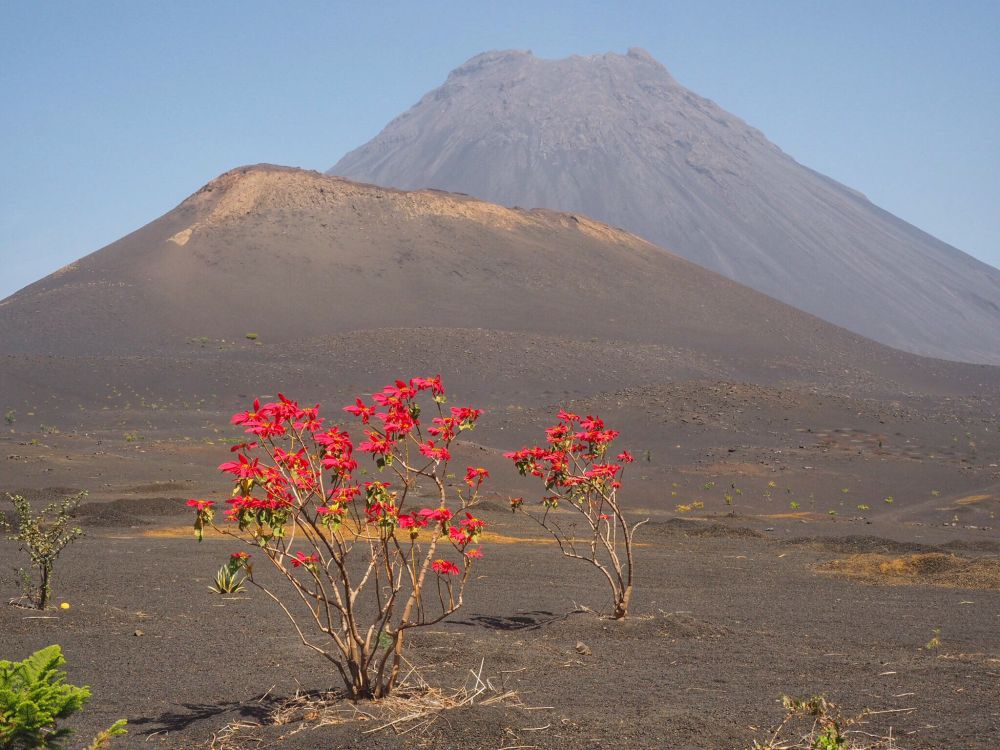
Sao Filipe
The main town of the island is Sao Filipe, which is very small and much more organized than Praia. It’s full of cute, colorful houses and you can visit the whole town within an hour. Although it lies next to the sea, I didn’t see anyone on the beach – as it wasn’t clear how one can get down there in the first place either as the town lies on a plateau, much higher than sea level.
The coolest place to stay at is the Colonial Guesthouse. Although I paid for the cheapest room, I received the largest one (I didn’t tell them I’m a blogger). It has a real colonial feel to it, with a small swimming pool on its patio (6.320 CVs a nigh)
Here you can find further places to stay at in Sao Felipe on Booking.com.
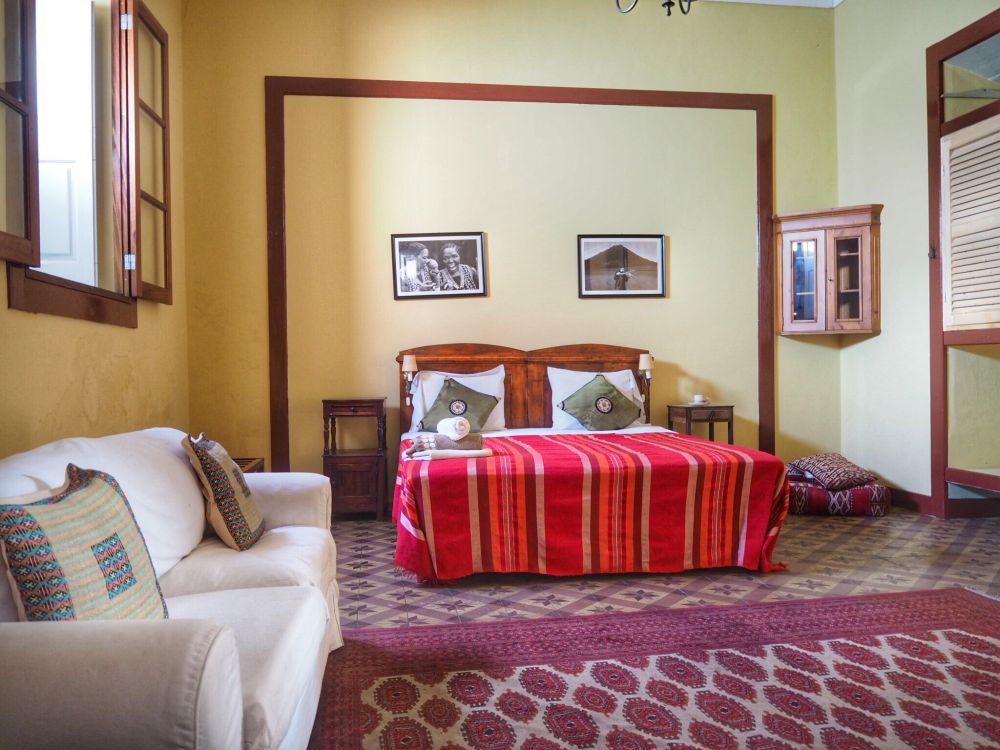
Zebra Travel, a small travel agency operates in the hotel, but they sell everything at a higher price than the agencies on the main square. I booked a half-day volcano trip with one of the latter agencies (Qalitur). The transfer there and back with photo stops and time for lunch cost 4.000 CVs. The same at the hotel would’ve been 15.000 CVs.
I did not see a car rental office, but would not recommend it anyway. For one according to guidebooks the daily rate starts at 75 CVs, and riding up to the volcano is better left to a local driver. Surfaced road only goes so far then you have to drive on a winding, mostly one lane trail. If you want to hike up to the top of the 2,829 m Pico peak, you can. In this case you should either book a whole day trip starting very early in the morning or spend the night by the crater in a guesthouse as the walk is 3-6 hours long. For dinner I tried the Tropical Club that’s a block down from my hotel, a place that seemed popular with the locals as well. I had a nice soup and grilled fish, which was quite a big portion.
Of the five islands Fogo became my favorite one: the island of cobalt blue sea, black lava-fields and farmers with a stubborn desire / will to live.
3. SAO VICENTE
Sao Vicente is not really on tourists’s map, and let’s admit, rightly so. It’s worth visiting for two reasons: one – you can take a boat to the island of San Antao from here (no planes go there), two – Cesaria Evora lived here.
One of the most notable towns of the island is Mindelo. You can visit it in a 1-2 hour walk as it hasn’t got many sights, although its pink presidential palace is quite a unique sight. Altoghether it’s a very pleasant town, orderly, clean squares and the ususal colorful houses.
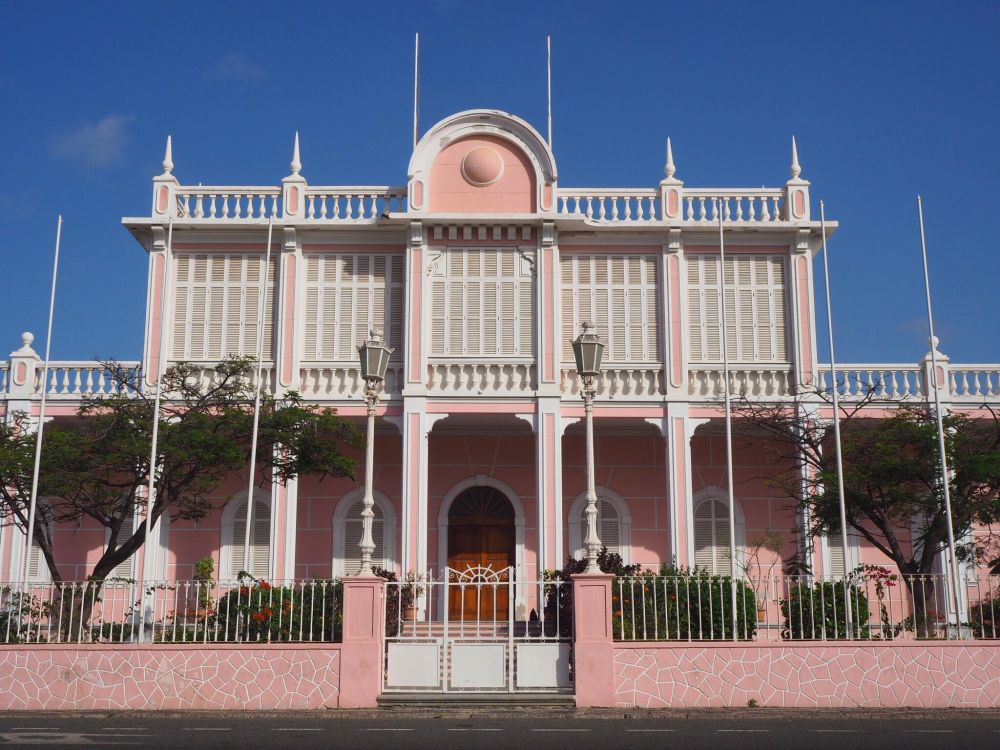
The museum of Cesaria Evora
The best experience though was definitely the visit to the museum of Cesaria Evora.
I for one did not count on having to hold back my tears within two minutes of entering the museum. But until then I didn’t know how extremely hard her life started out. It instantly became clear why sadness always lingered in her voice.
From her life written on the boards on the wall I found out that Cize, as everyone called her, learnt to sing from her violinist father. Her beloved father though died when she was seven years old, so the little girl was taken out of school and given to an orphanage. Her mother was very poor and could not support her six children. Ciza could not abide by the rules, so the problematic child ended up with her grandmother. At 16 she started singing in portside inns. That’s where she met her first love in her teens, a sailor with whom she spent many nights out – but the Portuguese musician got on a ship and never came back. At the age of 18 she found love in another sailor with whom she had a child, but the man never came back. She ended up like this twice more, meaning two more of her kids’ fathers left her.
Despite her humble living circumstances, no one ever saw the singer cry. She was a strong lady despite all hardships. She was known not to let anyone leave her house without having had a fruit jam sandwich and some candy even when she herself was living a hard life. She always wore her favorite apron and she managed to conjure up some cigarettes, candy or change from her pockets, whoever she met.
She remained a simple lady even when she was known and loved worldwide. She had no celebrity sense of entitlement. All she asked for was that there’s always cognac and cigarettes and that her coffee is hot. In the museum – as a sweet gesture towards her – they built a separate smoking corner, remembering the chain smoker singer.
She was in her forties when her career starated soaring. She gained international fame with her first album that debuted in France, titled The Barefoot Diva (La Diva aux Pieds Nus) – alluding to the fact that she never wore shoes when performing on stage. Later she received a Grammy and had concerts all over the world. She passed away at the age of 70 after ten years of retierment in her hometown of Mindelo.
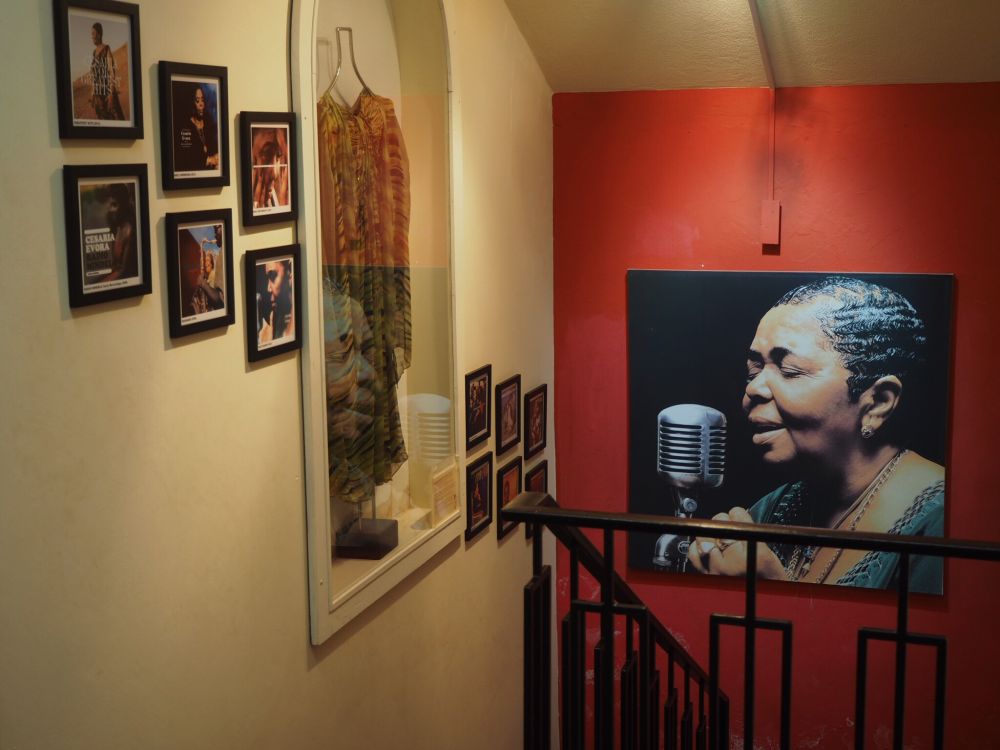
If I could’ve read her biography without crying, I would’ve burst into tears in the last room. Here they played scenes of her funeral which was the biggest event of the country. She was laid out in state in the pink presidential palace and everyone was there – from the president to almost the whole population of the country. The crowd pallbearing her was enormous, her coffin was carried by soldiers and accompanied by musicians. I had chills down my spine as I listened to the crowd as it sung one of Cesaria Evora’s favorite songs, Sodade.
Cape Verde locals are so proud of her – for many she was the one to make the country noticed – they named the airport in Sao Vicente after her. I took a selfie with the huge – naturally barefooted – statue that stands on the airport.
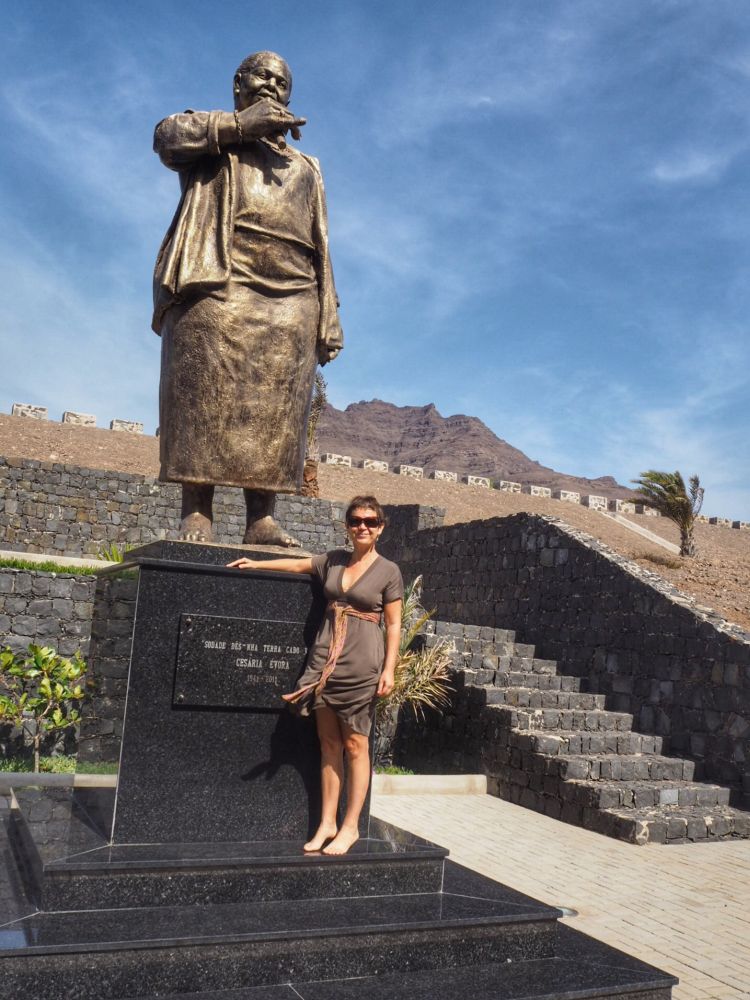
Market
I walked to the city market where I came across the first sign that the country was a Portuguese colony – some booths had the typical blue-white azulejos decorating them.
Baia das Gatas
The market is the place here where the minibuses leave from. Contrary to myself (the artful master of planning and excel sheets) I decided to go wherever the first bus was headed. There are only 3 routes after all on the island, all three leading to a different, small, sleepy town, so it makes no difference which way I start out. I found a minibus which I thought was full. And we actually really left quite soon afterwards. But I could not have been more wrong! Soon we stopped and packed in half of a small shop’s items. I got a dozen cartons of milk under my feet and a huge, 10 kg bucket of margarine (luckily empty) into my lap.
Baiaba, a beach town was only 20 minutes out. During weekdays its quite empty, but revives and fills with life during the weekend.
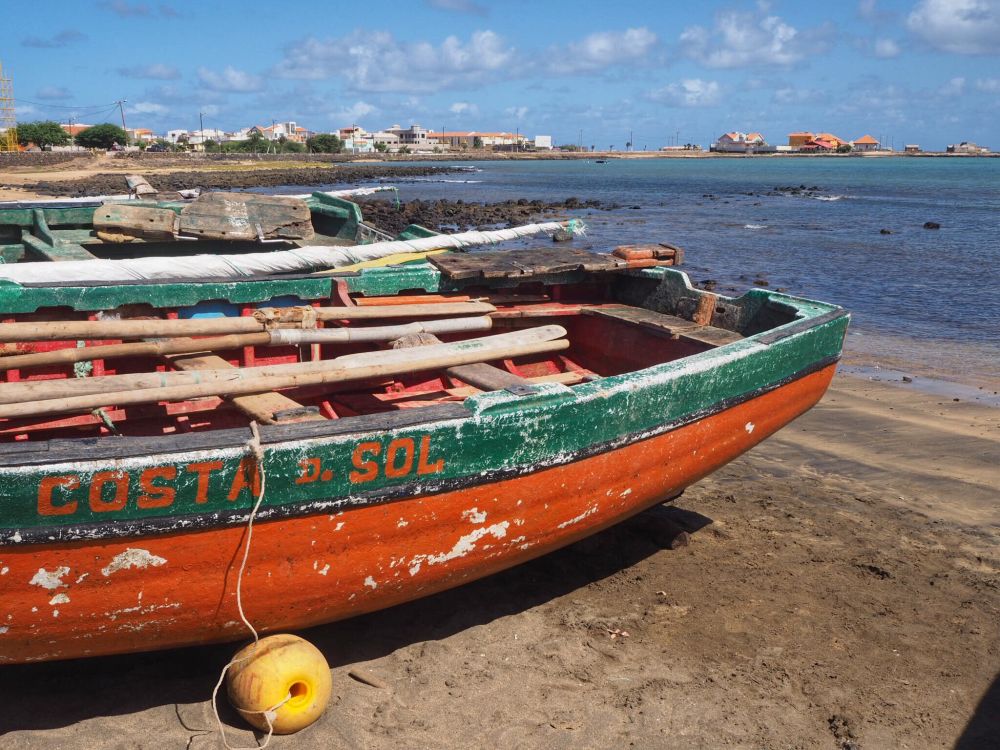
Accomodation
I stayed in the Basic Hotel for two nights, would not contest the name. It’s about a 20-25 minute wak from the center, but they have clean, simple little rooms with a bathroom for quite a good price (2000 CVs, about 5000 HUF).
Here you can find further lodging in Mindelo on Booking.com.
Restaurant
I had lunch in the Nautilius restaurant both days, I was so happy to find steamed vegetables here. It’s hard to eat healthy on the whole island, almost all meals overflow with carbohydrates.
All together Sao Vicente is not a huge deal, unless you’re a Cesaria Evora fan, it can be easily skipped and you can head straight to San Antao from the airport. But if you’re not in a hurry and would like to stay a few days, you won’t be disappointed either. Mindelo is typically the small town where you can slow down to local life and all at once feel like you belong.
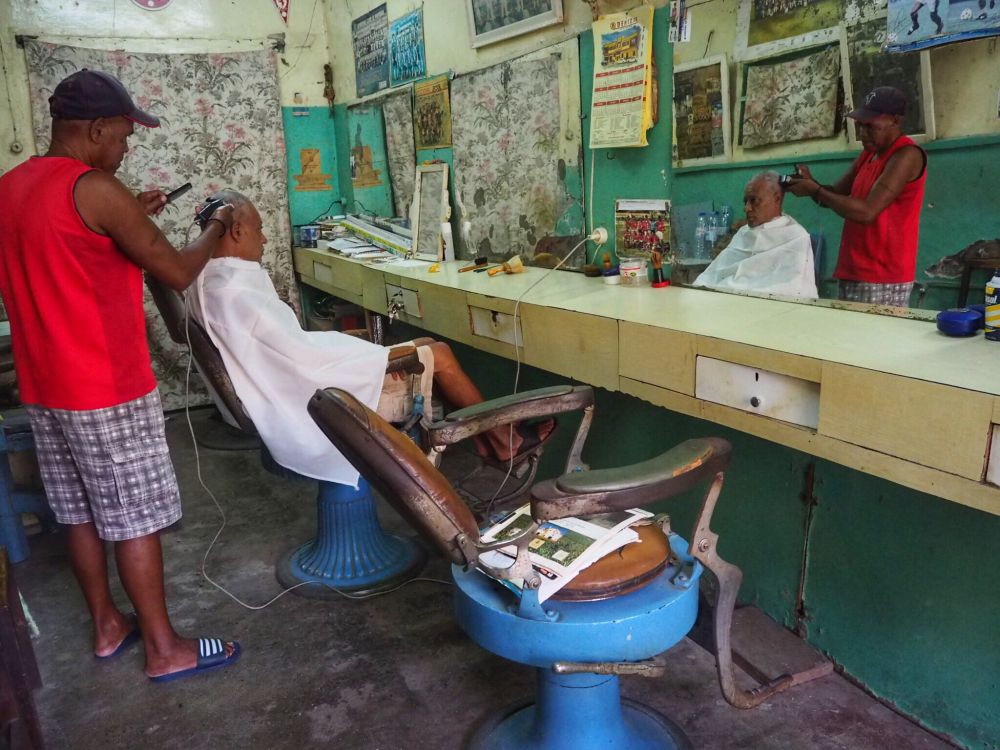
4. SANTO ANTAO
Santo Antao is the most suitable for hiking on Cape Verde, though surprisingly few people come for this. One of the reasons for this could be that there are no planes flying here. There is a runway but the flights are suspended because of the strong winds.
How to approach
You can cross over with a ferry from Mindelo, the port of neighboring island of Sao Vicente, the one way trip costs 800 CVs (8 euros) and lasts about one hour. If you’re prone to sea sickness, take a pill before the trip because the sea is quite rough here. There are two ferries per day: one leaves from Mindelo at 8am, and returns at 10 am. The other leaves at 3 pm and returns at 5 pm. There exists another ferry too – the Armas – with further departure times.
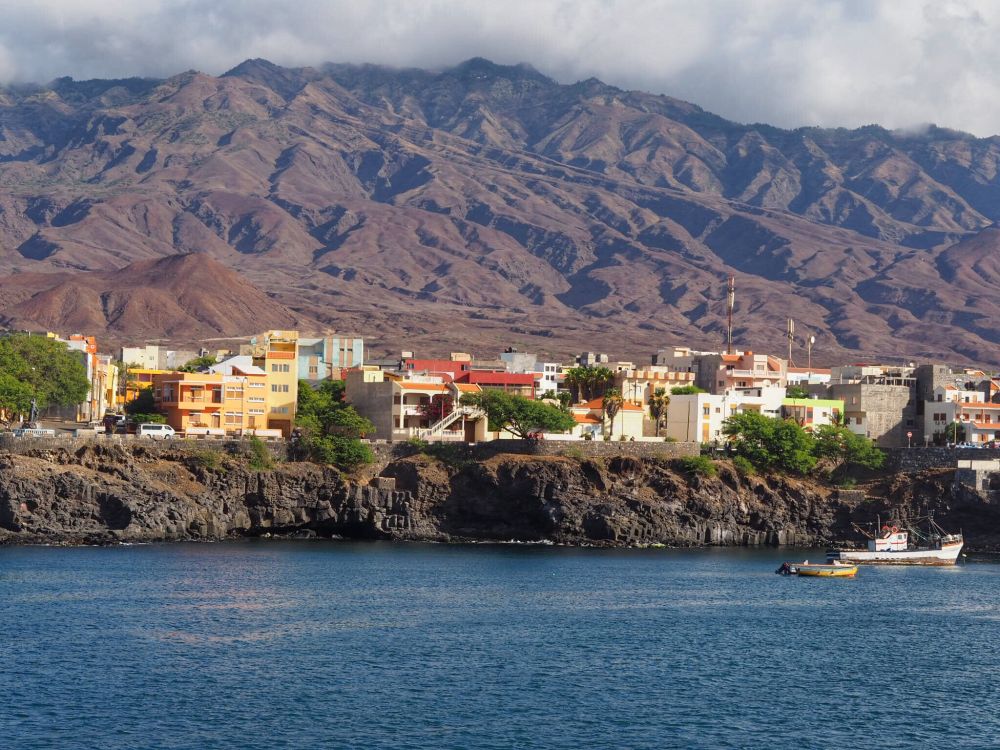
Transportation on the island
The ferry strikes the port of Porto Novo and looking at the map, all I saw was that most roads start from here. It seemed reasonable to have my accomodation in town and take the minibuses to a different area each day. As I arrived though, I realised that having few locals and few tourists can have a drawback too: public transportation is scarce. Minibuses don’t take the mountainous road across the island anymore since the more modern and comfortable road that runs along the beach was built. This latter leads to Ponta do Sol to the other side of the island. As it turned out it’s not Porto Novo but rather Ponta do Sol which is a more touristy town, though that does not mean more than two dozen tourists can be found there at the same time.
It’s very hard to reach the wild, romantic, western side of the island. There is only one minibus per day at most – at dawn – if there is a sufficient number of passangers at all. This minibus does not return the same day, so you have to spend the night. For hikers the best solution is to rent a private guide and ride, but since this is quite costly for one person, I skipped the opportunity. There was nothing I could do but hang around for a day.
Porto Novo
There are no sights worthy of a tourbook in Porto Novo, just colorful houses like elsewhere. In a mall with four shops I found a cafe where the menu was quite nice. Then I wandered along the only main street to pass time, and sat on the main square watching people.
Then I watched the sunset on the grey sandy beach and read my book in the evening. Actually a few such days of doing nothing can be quite nice.
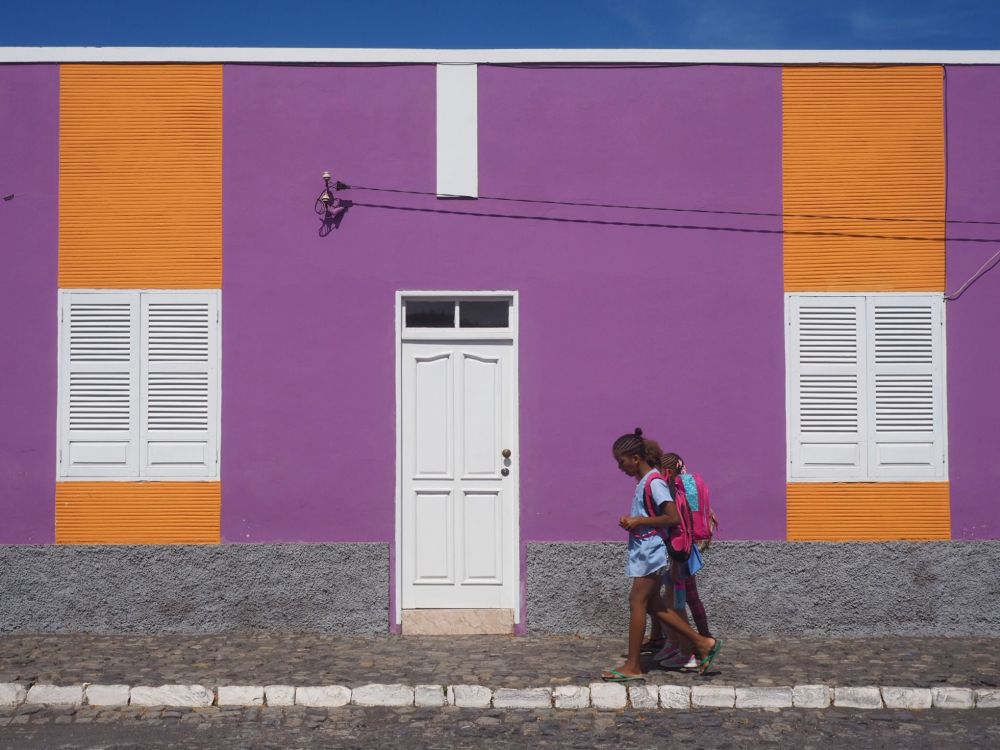
Ponta do Sol
Next morning I walked to the port around 9am when the morning ferry arrives because the minibuses accomodate their timetables accordingly and hunt for passengers on the way to Ponta do Sol. I did find one minibus for 400 CV. The trip was wonderful, I was kind of sorry for not having a private driver to be able to stop anywhere for a photo, but that would’ve cost too much. On one side of the road the huge, barren mountains, on the other the sea shining like silver in the cloudy weather.
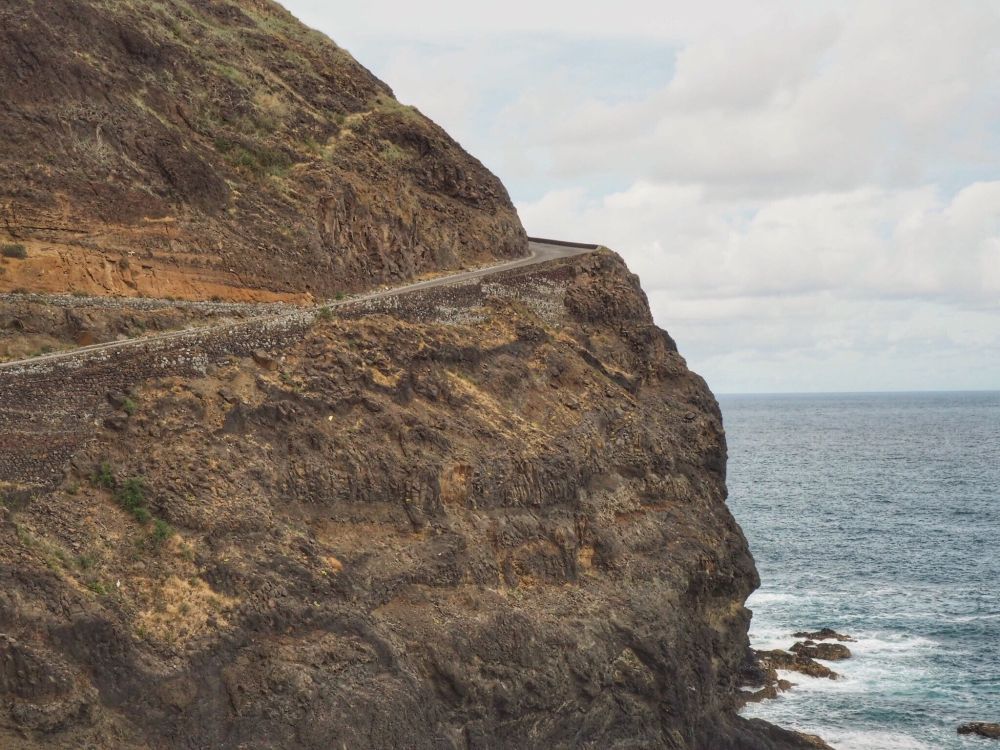
Ponta do Sol is a lively, colorful little town, with a very orderly and clean main square like it wasn’t even in Africa.
I wandered around then had lunch in Restaurant Calheta, recommended by a traveller colleague earlier. This lunch in the small 6-table restaurant by the sea was the best I had during the whole trip. I had grilled fish with mango sauce, all kinds of side dishes like pumkin puree and onion jam. I loved it!
I could not take a long hike here either, as the minibuses left to go back at 2pm to reach the ferry on time. On my last day I didn’t wait for the afternoon ferry, but took the morning one instead to Mindelo. It seems to be more lively there.
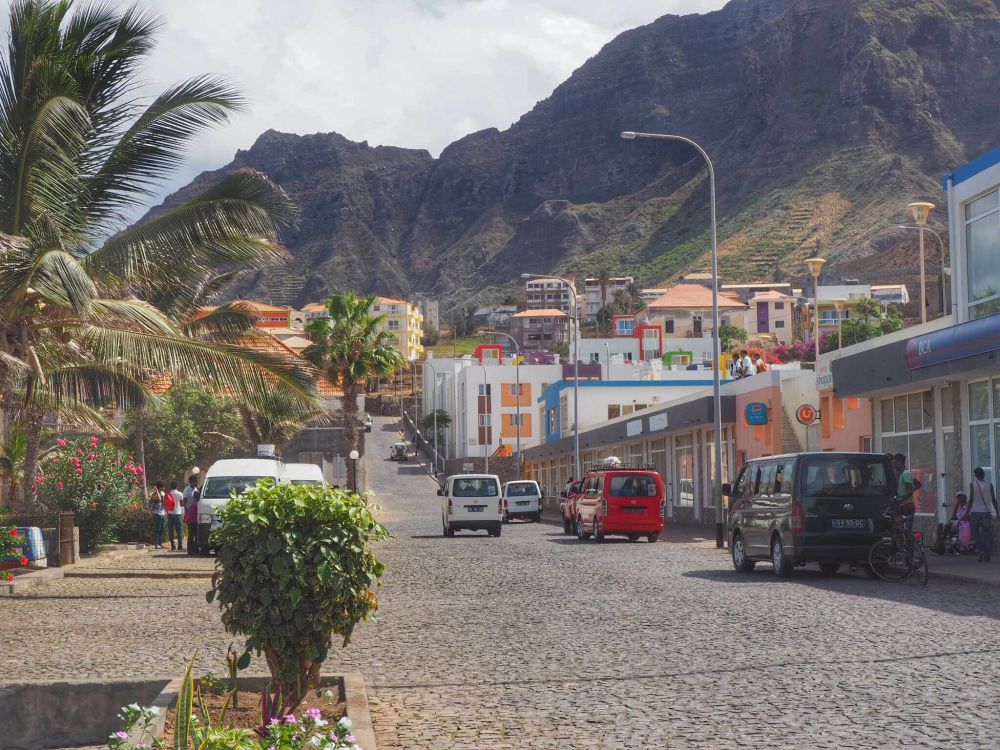
Accomodation
As I grew wary of the tiny hotel rooms, I booked a place through aribnb, cheaper than a reasonable guest house would have been. The friend of my host waited for me by the ship and walked with me to the place 3 minutes from there. Big living room with a kitchen, separate bedroom, bathroom, everything new and squeaky clean.
It’s hard to give advice regarding Santo Antao because it’s a beautiful but hard to process island. It’s romantic because there are no big hotels and infrastructure is usually little – if it were to get bigger, it would be easier for travellers, but the magic would be gone. It you come 3-4 of you together, it’s worth renting a private taxi and driver, in which case you can take beautiful trips. Trips like this cost 80-100 euros per day (car including the driver). For solo travellers I cannot recommend the island if they don’t want to spend a lot of money, because public transport here is scarce – as you can see from my example, I could only glimpse its beauty. So come as a group!
5. SAL
Sal is not only a different island, it’s like a different country. Or planet. Although I prepared myself from the guidebook, I was astonished how barren this island is. In contrast to the other islands, there are no dramatic mountains or rolling hills with forests. It’s all flat and bleak. The view from its highest point is this:
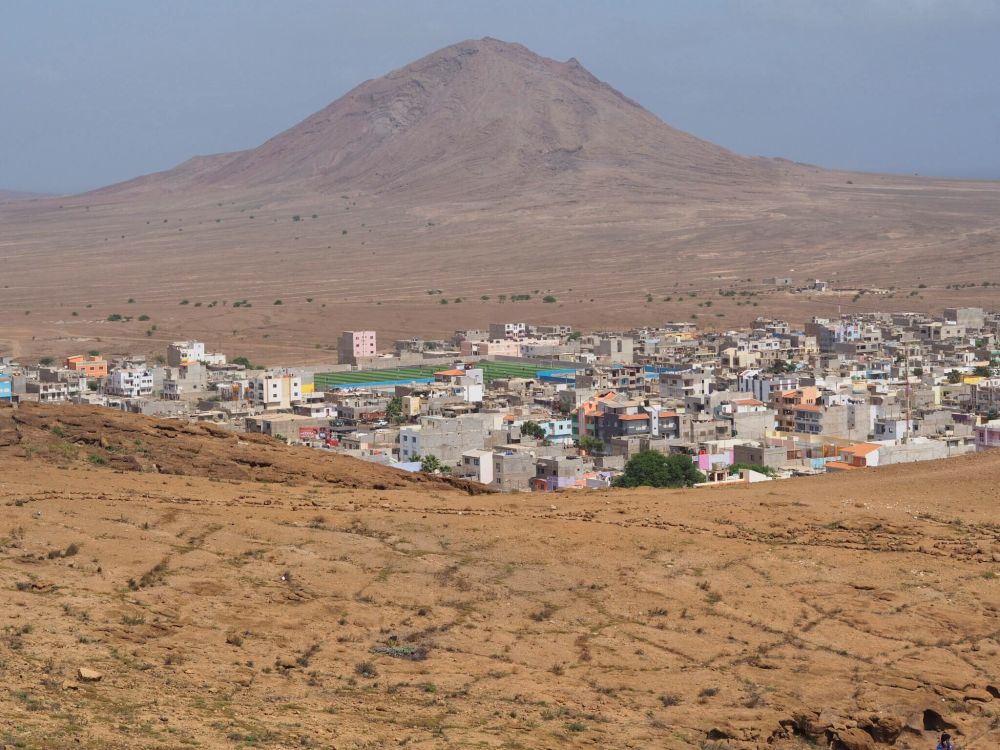
On Sal there is sun, sand, wind and salt. For centuries everything revolved around salt, it was the main industry. Then in the past decades tourism became the main industry. Visitors these days come for the constant summer weather, the sandy beaches and the wind which is perfect for surfing.
Santa Maria
From the airport, practically all tourists go to Santa Maria, the largest beach of the island, as you can find all of the large hotels here. There are no minibuses, and the taxi takes about 15-20 minutes and costs 1000-1500 CVs. There is nothing to see in Santa Maria besides the beach, but all the travel agencies and restaurants are situated here, so it’s worth finding your accomodation here even if you aren’t an all-inclusive type.

Beach
I arrived late in the morning. I spent the day walking into downtown, had lunch, wandered a bit and spent the afternoon on the beach, waiting for the sunset.
Half-day trip on the island
I had a whole day next, so I booked a half-day trip. There are millions of these and I had no inclination to look for hours just for a price that’s 5-10 euros lower, so I booked with the agency that seemed serious enough and was closest to my apartment. For 35 euros they took us around the island from 9am – 2pm to see all of its main sights.
We went to a beach where the largest waves could be found. Then we went to a steppe / heath where we saw a real mirage. Then up to a lookout from where we could see the capital of Espargos and its slum as well.
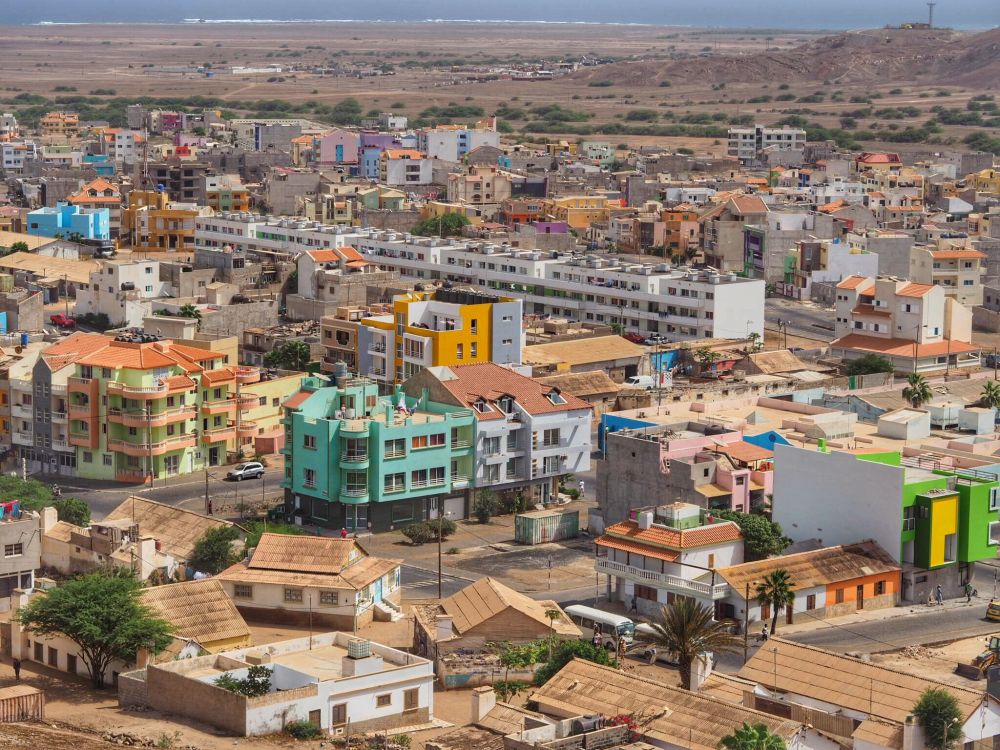
On one of the beaches the other passengers went knee deep into the water to see small sharks, but I skipped that. I had a feeling – which later turned out to be true – that the sharks are not there naturally, they are lured there by food. As for me, I try to boycott all animal programs that tamper with the natural order of things.
Then we visited a place called „blue window” where in theory you could see a very pretty deep lake, but its color is nicest around midday, so when we were there around 10am, it was not a big sight at all. But in the end we went to a salt refinery which I really liked. This was worth the whole half-day trip – and I could not have come here with public transport.
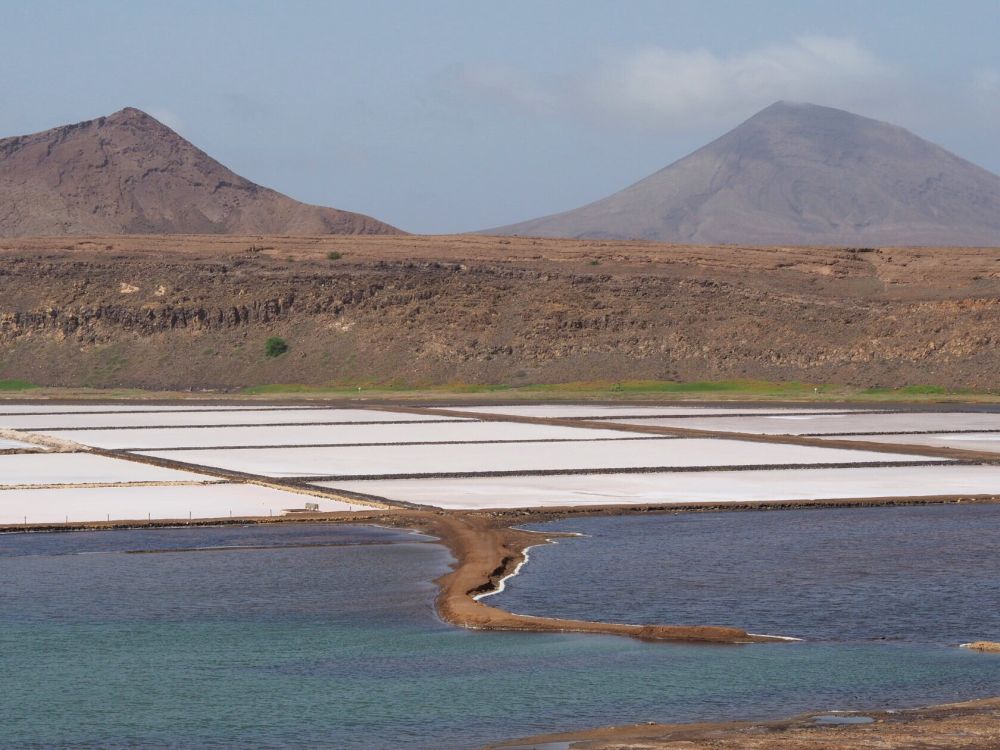
Accomodation
According to Booking.com 90% of the accomodation was booked during these weeks, so I could not find the right place to stay. The situation was further complicated by the fact that there are two types of accomodation here: the all-inclusive, expensive resorts and the loud guesthouses of the bleak towns.
Now that’s when Airbnb can be a life saver. I stayed in an apartment complex, which is owned by investors and when they’re not here, they sublet it. A small apartment with two stories (a kitchen and living room and terrace downstairs and bedroom, bathroom, balcony upstairs) cost me 50 euros per day. It cuold fit 4 people even. Pool, two dogs, a cat (Prince), a 5-minute walk to the sea, lots of restaurants within walking distance, yet it was quiet.
Here you can find further accomodation in Santa Maria on Booking.com.
Cape Verde experience – which island is the best?
All together this trip was great too, I recharged my „solar cells” for winter. Good weather is guaranteed, no jetlag and safe – these are all the pros of the country. Whereas in 1991 there were only 19.000 visitors to the country, there are more than half a million today, and growing. In contrast to other regions of the world, this is the island of peace, where there is no sign of terrorism or diseases. When I asked fellow travellers why they were there, the main reason apart from being relatively close to Europe was safety.
Which island do I recommend?
If your wish is to spend a week in the sun because you’ve had a hard time lately or have no inclination to take hikes, your best bet is Sal and Boa Vista. Sal – let’s confess – is a little ugly but nature compensates for this with the most beautiful beaches and the longest, golden beach. That’s why the huge all-inclusive resorts are set here and that’s why most tourists come here. They set foot in the hotel, not to leave it again until their departure. Why would they? The beach, the food is all there, and not much else is to see on Sal.
But people visiting Sal miss out on the unique vibe of Cape verde. All that I loved so much on the other four islands is missing here. There are more pizzas on the menus of restaurants than cachupas, and it’s western music playing in the bars, not morna.
So if you want to get to know the country more, do visit one of the lesser known islands!
